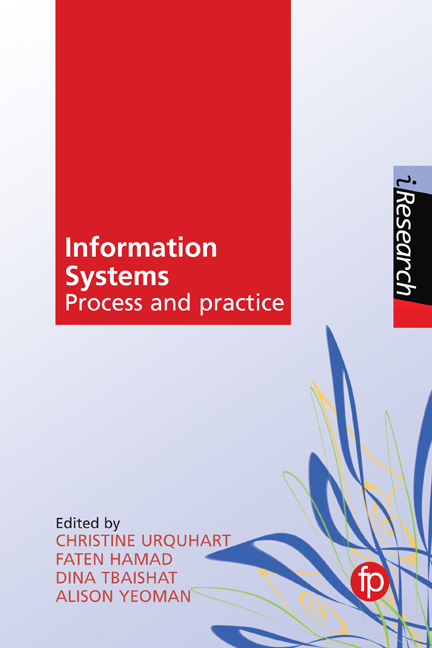Book contents
- Frontmatter
- Contents
- List of tables and figures
- Series editor's foreword
- About the authors
- 1 Introduction
- 2 Approaches to information architecture
- 3 Taxonomy testing for information architecture
- 4 The enterprise website and its information structures
- 5 Analysing activities, roles and processes
- 6 Libraries and the organisation of library processes – a history of operational research, and the use of process modelling
- 7 Using Riva process modelling to study book acquisition in academic libraries
- 8 Workflow analysis and process mapping in US academic libraries
- 9 A theoretical framework for designing and evaluating semi-structured document triage interfaces
- 10 Resource discovery case studies
- 11 Increasing social connection through a community-of-practice-inspired design
- 12 Methods for studying information provision, networking and communication in patient support groups
- 13 Health information systems: clinical data capture and document architecture
- 14 Producing systematic reviews and getting evidence to the clinician
- Index
13 - Health information systems: clinical data capture and document architecture
Published online by Cambridge University Press: 08 June 2018
- Frontmatter
- Contents
- List of tables and figures
- Series editor's foreword
- About the authors
- 1 Introduction
- 2 Approaches to information architecture
- 3 Taxonomy testing for information architecture
- 4 The enterprise website and its information structures
- 5 Analysing activities, roles and processes
- 6 Libraries and the organisation of library processes – a history of operational research, and the use of process modelling
- 7 Using Riva process modelling to study book acquisition in academic libraries
- 8 Workflow analysis and process mapping in US academic libraries
- 9 A theoretical framework for designing and evaluating semi-structured document triage interfaces
- 10 Resource discovery case studies
- 11 Increasing social connection through a community-of-practice-inspired design
- 12 Methods for studying information provision, networking and communication in patient support groups
- 13 Health information systems: clinical data capture and document architecture
- 14 Producing systematic reviews and getting evidence to the clinician
- Index
Summary
COMMENTARY: ALISON YEOMAN
In this chapter, Faten Hamad looks at the challenges facing developers of health information systems. The chapter first provides an overview of how the concepts of information architecture can be applied in the context of healthcare systems. In Chapter 2, the author has explained that the key to successful information architecture is to create a structured, shared environment that is accessible and meets the needs of users. She pointed out that users often have different needs, preferences and behaviour, as noted also by Rosenfeld, Morville and Arango (2015). Consequently, designing a system that works effectively for all users is not easy.
This is particularly true in the case of healthcare, a system that can be viewed as both ‘complicated’, because of the number of components in the system (e.g. the number of users of a particular computer interface), and ‘complex’, because of the web of relationships and interactions between healthcare professionals, professionals and patients (Kannampallil et al., 2011). In the introduction Hamad identifies five challenges for developers working in this environment:
• a lack of resources and evidence base
• legacy information systems developed for particular functions, which do not integrate well with other systems
• a lack of information sharing
• the need for rigorous safety management systems and regulatory mechanisms
• the sheer volume of information that healthcare organisations have to manage.
She then considers clinical data management and the importance of data sharing including the challenges of combining information from different sources or in different formats and ensuring that staff enter data correctly.
Hamad cites Almunawar and Anshari (2012), who describe health information systems as sitting at the intersection between the business of healthcare provision and the information systems to support clinical work. She explains that ‘clinical research and investigation’, where the emphasis is on case reports and ‘big data’ (the collection of large amounts of data), has benefitted from recent advances in technology and electronic data capture, which is explored in Section 13.4. For general health information systems, on the other hand, the emphasis is on effective information exchange and communication. This leads to a discussion of electronic health records, the challenge of integrating them with electronic data captures, and developing HL7 (Health Level Seven) standards to support the efficient and secure exchange of health information.
- Type
- Chapter
- Information
- Information SystemsProcess and Practice, pp. 233 - 254Publisher: FacetPrint publication year: 2017

